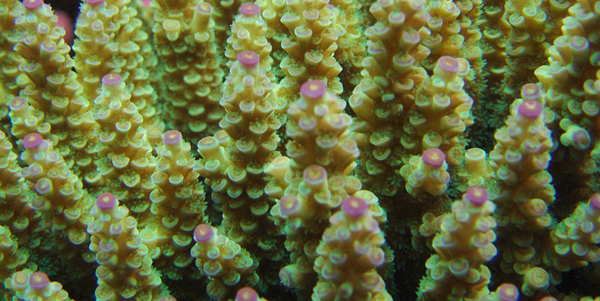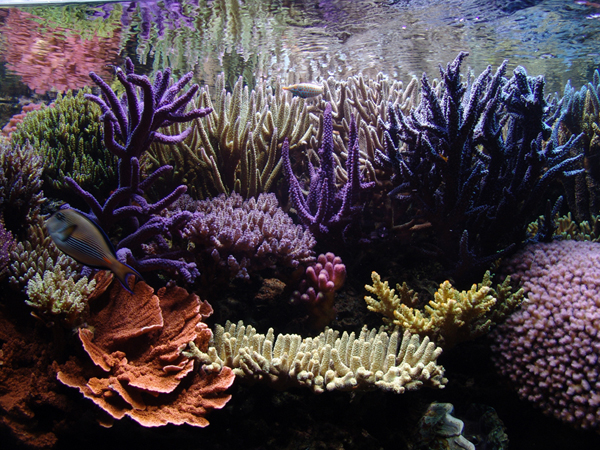 Tank of the Month
Tank of the Month
Tank of the Month
Ferdinando D'Amora's (Nando-Italy) Reef Aquarium
 |
Introduction and Background
First of all, many thanks to Reef Central for giving me the chance to show my reef tank to the community. My passion for this hobby started when I was 10 years old. I went to my friend’s house and saw his father’s aquarium full of freshwater tropical fishes. After that, I started to keep little red goldfishes in the typical glass bowl because I was too young to manage a big aquarium. When I was 12 years old, I built my first aquarium with recycled glass. After that, I built bigger and bigger aquariums until the last one, which is the biggest I’ve ever had. This was in 1999, and it worked as a freshwater aquarium until the first months of 2002. One day I went to a local fish store and saw all the beautiful tropical marine fishes, so I decided to turn my passion toward a marine tank.
My first intention was to set up a fish-only tank, but after a while I came in contact with corals and became addicted! So I modified my tank to keep corals in the best way possible, even though this has been very difficult as the tank was originally set up for freshwater purposes. Since 2002 I had lots of experiences, sometimes good and sometimes bad ones but my huge passion for this hobby always helped to overcome the difficult moments. Encouraged by my passion, I’ve always tried to improve my “little bowl” throughout the years and the feeling that “ the other tanks are always better” never left my mind, despite the decent results I’ve recently managed to reach.
Here’s a picture sequence that documents how my tank has evolved over the years...
The Current System
The total volume of the system is about 800 liters (210 galllons) - the tank is 600 liters (160 gallons) and the sump (with frag tank) is 200 liters (50 gallons). The tank's measurements are 180 x 60 x 60 cm, and it's built with 10mm thick glass, visible on the front and part of both sides. The back glass is covered by a synthetic rockwork as I think the classic blue or black colored back glasses don’t look really natural.
With great difficulty, because the front to back size of only 60 cm, I’ve managed to create a reasonable perspective in my layout. The bottom, after I tried lots of different solutions, is covered with a thin layer of coral sand. Thicker layers always caused a problem with slime algae but maybe in the future I will try to run a proper deep sand bed tank.
 |
System Profile
• Display tank: 600 liters (160 gallons)
• Sump: 200 liters (50 gallons)
• Lighting display: XM 250-watt 10,000K metal halides and ATI procolor and blue-plus T5 neons
• Photoperiod: 12 hours
• Water circulation: 3 Tunze 6100 and 2 Tunze 6200
• System filtration: Sander C200 ozonizer
• Skimmer: AQ Engineering 200SK
• Calcium reactor: modified Deltec PF600S
• Additives: magnesium, strontium, boron, potassium, iron, fluor and trace element mixture
• Chiller: Teco CA680
Filtration
In the past I tested many filtration systems, and discovered that the best system for my tank was also the easiest: a good protein skimmer. Given that my tank is full of corals and very mature, most of the filtration job is handled by live rocks and by all the micro-organisms living in the rocks. For this reason I chose a very powerful skimmer, but one that was not too big, in order to avoid depleting too many nutrients. At the moment I’m using an AQ Engineering 200SK skimmer. Ozone is also used occasionally to take phenols out of the water, and for this purpose I have a Sander C200 ozonizer.
One of the biggest problem I’ve always had in my tank was maintaining the calcium level in an optimum range. The tank is now well-populated with very big stony corals that absorb a lot calcium, and I could not install a big calcium reactor because of space constraints. Therefore, I modified my Deltec PF600S calcium reactor by installing a bigger pump and by moving the flow regulating valve at the exit hose of the reactor. This way, the coral gravel inside it melts like snow in the sun!!
Lighting
The lighting system is certainly one of the most important pieces of equipment in a reef tank. Over the years I've tested all methods/types of lighting, with the aim of finding the best lighting solution for the tank. I tried T8, T5, HQI 150-watts, 250-watts, and 400-watts in bulbs of different brands and different light spectrums. I finally decided to build a self-made lighting system using a mix of HQI metal halide bulbs and T5s in order to cover the whole tank without any shadow zones.
Between all the HQI bulbs I have tested in the past, I found a good compromise with the XM 250-watt 10,000K bulbs. In my opinion, they have a very good appearance at first sight, and they also have a good spectral emission. They’re powered by Icecap ballasts. For supplementation, I also added some ATI procolor and BluePlus T5 neon bulbs.
The system's photoperiod is as follows:
- 4 x 250-watt XM 10,000K, running about 11 hours
- 8 x 39-watt ATI T5s, (4 Procolor + 4 BluePlus), running about 12 hours
Water Circulation and Flow
Another crucial factor to be considered in a reef tank is the water movement. It has to be more homogeneous as possible in all the parts of the aquarium, trying to avoid the presence of stagnant zones behind the rocks and everywhere else in the tank. For these reasons, I used Tunze stream pumps, well-positioned and hidden (I hate to see those horrible black boxes hanging around), because they have the good feature of a very big flow but at the same time this flow is not violent or deep. Over the years, I've had to change the direction of the pumps' flow many times. I also added some pumps as the corals have grown because their growth has prevented good water circulation.
At the moment I use:
- 3 Tunze Stream 6100
- 2 Tunze Stream 6200
|
Water Parameters:
|
 |
Maintenance, Feeding & Supplements
The whole system is monitored by a dedicated computer system called Aquasmart Limulus, which allows me to run all the various equipment and to check levels of pH, ORP, density and temperature. Temperature is kept under control with a Teco CA680 chiller and a Shego 300-watt heater.
With the use of dosing pumps, the following elements are added on a daily basis: magnesium, strontium, boron and potassium. Sometimes, when required, I also dose iron, fluor and a trace element mixture. Monthly water changes are done with about 100L of RO water mixed with Tropic Marine Pro Reef salt.
I very rarely feed my corals. After trying several methods and coral foods, I came to the conclusion that, in my tank, which is well stocked with fishes, target feeding of corals is useless. I believe that the fishes' waste itself feeds the whole benthonic and planktonic chain, and this benthos and plankton is what feeds my corals. I feed my fishes once a day with crumbles or flakes in large quantities, and that’s it. If I notice any signs of starving in the corals, I add a bit of Golden Pearls or other liquid food specifically designed for corals.
Livestock
The tank contains mostly SPS corals. Here is a list of other invertebrates and fish that inhabit my system.
- 1-Oxymonacanthus longirostris
- 1-Paracanthurus hepatus
- 1-Acanthurus sohal
- 2-Pseudocheilinus hexataenia
- 1-Pterosynchiropus picturatus
- 2-Pomacentrus moluccensis
- 3-Amphiprion ocellaris
- 2-Labroides dimidiatus
- 1-Gobiodon okinawae
- 1-Ophiarachna incrassata
- 1-Linckia sp. starfish (blue)
- 3-Lysmata amboinensis
- 5-Rhynchocinetes uritai
Acknowledgements
Again, many tanks to Reef Central for giving me the opportunity to show my tank on Reefkeeping Magazine and many thanks to all my friends of reefitalia.net, the Italian reefkeeping forum, who shared lots of their experiences over the years that contributed to the results in my tank as seen in this article.
 |
Special thanks to the whole staff of reefitalia.net for their support and especially to Marco Negro (aka McPhisto) and Luca Girlando (aka lucasabao) for their help in translating this article.
Feel free to comment or ask questions about my tank in the Tank of the Month thread on Reef Central.



